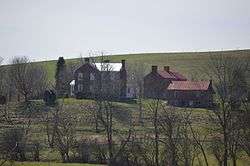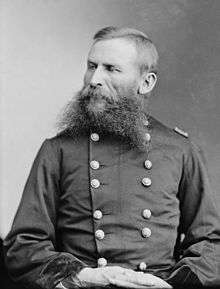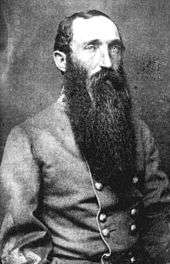Battle of Cloyd's Mountain
The Battle of Cloyd's Mountain was a Union victory in western Virginia on May 9, 1864 that allowed the Union forces to destroy the last line connecting Tennessee to Virginia.
Background
Brigadier General George Crook commanded the Union Army of West Virginia, made up of three brigades from the Division of the Kanawha. When Ulysses S. Grant launched his spring offensive of 1864, two Union armies marched towards Richmond and a third moved into the Shenandoah Valley. Crook's troops were also involved in the offensive and began to march through the Appalachian Mountains into southwest Virginia. His objective was to destroy the Virginia & Tennessee Railroad, working in conjunction with William W. Averell's offensive, which had similar objectives. Brig. Gen. Albert G. Jenkins was in command of the few scattered Confederate units protecting the rail lines. He had assumed command only the day before Crook's army began to approach the railroad.
Nevertheless, Jenkins was an experienced soldier. During the 1863 Gettysburg Campaign, Jenkins' Brigade had formed the cavalry screen for Richard S. Ewell's Second Corps. Jenkins led his men through the Cumberland Valley into Pennsylvania and seized Chambersburg, burning down nearby railroad structures and bridges. He accompanied Ewell's column to Carlisle, briefly skirmishing with Union militia at the Battle of Sporting Hill near Harrisburg. During the Battle of Gettysburg, Jenkins was wounded on July 2 and missed the final day's fighting. He did not recover to rejoin his command until autumn. Jenkins spent the early part of 1864 raising and organizing a large cavalry force for service in western Virginia. By May, he had been appointed Commander of the Department of Western Virginia with his headquarters at Dublin.
Battle

Jenkins, having decided to make a stand at Cloyd's Mountain, set up a strong defensive position. When Crook arrived, he decided against a frontal assault, concluding that the Confederate works were too strong and such an attack would decimate his army. The surrounding area was heavily forested and Crook used this as cover to swing his brigades around to the Confederate right flank.
Crook began the battle with an artillery barrage, then sent in his brigade of green West Virginians under Colonel Carr B. White. Crook's remaining two brigades under Colonel Horatio G. Sickel and future president Colonel Rutherford B. Hayes were to launch a frontal assault as soon as the West Virginians had gotten under way. Serving as a major under Hayes was another future U.S. President, William McKinley. White's brigade, in its first fight, advanced to within 20 yards before heavy casualties from its exposed position forced it back. Crook, moving with Hayes' Ohio brigade, had to dismount and walk the slopes on foot because they were so steep. Still wearing his jack boots, he sank in a small stream the troops were crossing and his boots filled with water. Nearby soldiers rushed back and pulled him out.
Hayes' brigade spearheaded the main assault around 11 a.m. The troops fought their way to the Confederate works and severe hand-to-hand fighting ensued. Sparks from the musket fire ignited the thick blanket of leaves on the ground, and many men from Sickel's and Hayes' brigades were pinned down and burned alive. The brigades had begun to fall back, when Crook sent two fresh regiments into Hayes' front. The West Virginians finally advanced against the artillery and overran its crew. The Ohio troops now began to overwhelm the Confederate center. Jenkins tried desperately to shift troops to the threatened areas, but he fell severely wounded and was captured. His second-in-command, John McCausland, took command and conducted a rear-guard action as he withdrew his troops.
The Battle of Cloyd's Mountain was fought on the Back Creek Farm. The farmhouse served as a hospital and as headquarters for the Union General George Crook.[1]
Results
The battle of Cloyd's Mountain was short and involved few troops, but it contained some of the most severe and savage fighting of the war. The engagement lasted a little over an hour, with much of that being hand-to-hand combat. Casualties were high for the modest number of troops involved. Crook lost 688 men, roughly 10% of his force. The Confederates lost fewer men—538—but that totaled 23% of their total force. The battle is considered a Union victory because Crook was able to continue on and destroy the Virginia and Tennessee Railroad at Dublin, Virginia, and Averell was also able to destroy several railroad bridges along the same line, severing one of the Confederacy's last vital lifelines and its only rail connection to East Tennessee. The day after the battle, the remaining Confederate troops unsuccessfully defended a railroad bridge over the nearby New River. In the melee, a soldier who refused to take cover until Col. Hayes did so was mortally wounded. While undergoing first aid, the soldier was found to be a woman.[2]
Order of battle
Union

Kanawha Division — Brig. Gen. George Crook
- 1st Brigade — Col. Rutherford B. Hayes
- 23rd Ohio Infantry — Lt. Col. James M. Comly
- 36th Ohio Infantry — Col. Hiram F. Devol
- Detachment, 34th Ohio Infantry — (attached to 36th Ohio)
- 5th West Virginia Cavalry (Dismounted) — Colonel Abais A. Tomlinson
- 6th West Virginia Cavalry (Dismounted)
- 2nd Brigade — Col. Carr B. White
- 12th Ohio Infantry — Col. Jonathan D. Hines
- 91st Ohio Infantry — Col. John A. Turley
- 9th West Virginia Infantry — Col. Isaac H. Duval
- 14th West Virginia Infantry — Col. Daniel D. Johnson
- 3rd Brigade — Col. Horatio G. Sickel
- 3rd Pennsylvania Reserve Regiment — Capt. Jacob Lenhart
- 4th Pennsylvania Reserve Regiment — Colonel Richard H. Woolworth (killed)
- 11th West Virginia Infantry — Col. Daniel Frost
- 15th West Virginia Infantry — Lt. Col. Thomas Morris
- Artillery — Capt. James R. McMillin
- 1st Ohio Battery — Lieut. G.P. Kirtland
- 1st Kentucky Battery — Capt. David W. Glassie
Confederate

Department of Southwestern Virginia — Brig. Gen. Albert G. Jenkins (wounded and captured); John McCausland
- 4th Brigade — Col. John McCausland
- 45th Virginia Infantry — Col. William H. Browne
- 60th Virginia Infantry — Col. Beuhring H. Jones
- 36th Virginia Infantry — Lt. Col. Thomas Smith (wounded) Maj. William E. Fife
- 10th (Diamond's) Kentucky Cavalry (Dismounted) (400 men)
- 45th Virginia Infantry Battalion — Lt. Col. Henry M. Beckley
- Home Guards
- Artillery — Capt. Thomas A. Bryan (wounded)
- Botetourt (Va.) Artillery — Capt. H.C. Douthat
- Bryan's (Va.) Battery — Lieut. G.A. Fowlkes
- Ringgold (Va.) Battery — Capt. Crispin Dickenson
- Morgan's Brigade — Brig. Gen. John Hunt Morgan (brigade arrived late and took part only in the retreat)
- 5th Kentucky Cavalry - Col. D. Howard Smith
See also
- Valley Campaigns of 1864
References
- Virginia Historic Landmarks Commission Staff (February 1975). "National Register of Historic Places Inventory/Nomination: Back Creek Farm" (PDF). Virginia Department of Historic Resources. Archived from the original (PDF) on 2015-09-24. Retrieved 2013-10-01.
- Hoogenboom, Ari (1995). Rutherford B. Hayes: Warrior & President. University Press of Kansas. pp. 163–164.
- Kennedy, Frances H., editor, The Civil War Battlefield Guide: Second Edition (1998)
- National Park Service battle description
- Description of forces
